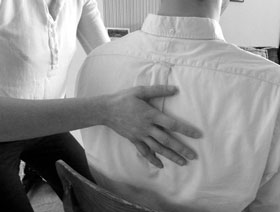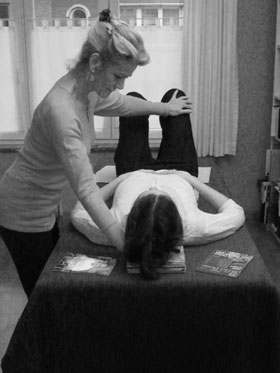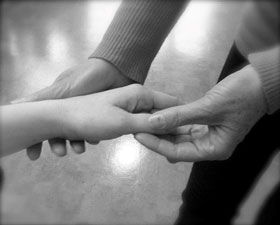HOW IS THE ALEXANDER TECHNIQUE TAUGHT ?
Practical considerations
Lessons in the Alexander Technique can take many forms: most often individual lessons but also workshops, theorectical and/or practical introductions and lessons in small groups.
Individual lessons generally last between 30 and 45 minutes.
In order to develop a good understanding of the Technique you should think of a minimum of 30 lessons, at a frequency of between one and five lessons per week. (F.M. Alexander asked his pupils to come every day at the beginning and then progressively reduced the frequency depending on the pupil’s evolution).
No special clothing is necessary. You do not need to undress but you may be asked to take off your shoes.
Prices depend on the teacher.
The lesson
In an Alexander Technique lesson we learn principles that can be applied to all of our activities. We do not do “exercises” but explore these principles using every day movements, such as moving from sitting to standing, bending, reaching with the arms. The lesson is like a reduced version of real life, giving us a safe environment in which to develop skills which can then be applied in more complex situations. One of these skills is simply a clearer awareness of what we are doing with ourselves.
Of course, acquiring this takes time and repetition; essential ingredients in the learning process.
We teach people to become aware of the unneccessary strain and overtension they make in everything they do, so that they need not continue to misuse themselves in this way.
– Marjory Barlow
Learning through experience
It takes time partly because what we are learning is not intellectual.
Verbal explanations are part of the teaching; intellectual understanding is important; but we really learn through experience. The teacher needs to communicate a new sensory experience of muscular balance and coordination and we can do this most efficiently through touch. The teacher manually guides the pupil in stillness and in movement, using his hands to assess kinesthetically what the pupil is doing, to bring their attention to areas they may be unaware of and to invite, non verbally, another way of being.
Little by little, the teacher helps reorganize the tonus of the entire muscular system and guides the pupil in becoming better aligned in space.
The teacher’s precise, gentle and non-intrusive touch simultaneously guides and monitors. The ability to teach a pupil in this receptive way is a skill that depends ultimately on the teacher’s own presence and co-ordination.
The teacher-pupil relationship is an essential part of the learning process. Indeed, there is a continual exchange and collaboration between them. In allowing himself to be guided, the pupil consciously enters into the process of setting aside his habitual way of doing things. The teacher, in turn, must provide a good model. He himself must apply the principles of the Alexander Technique in the act of teaching so that he communicates good use to the pupil in different ways: through his attitude, his way of moving, his touch.
Teacher and pupil share a presence in the moment and a consciousness in action. It is for this reason that learning the Alexander Technique is based on individual work.



